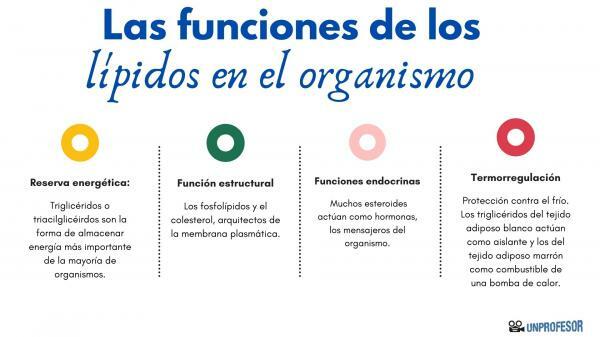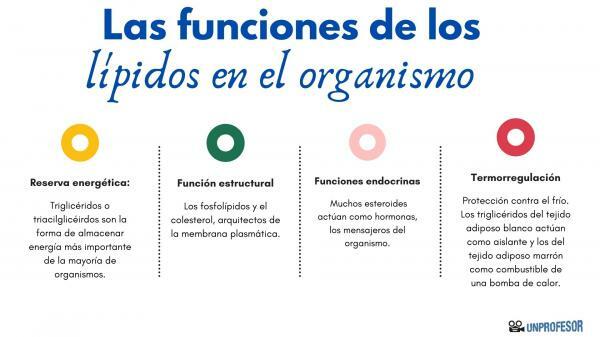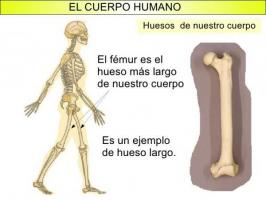Function of LIPIDS in the body

Contrary to what happens with other groups of biomolecules, lipids or fats they are a very diverse group in terms of their composition and chemical structure. The only thing they have in common is that, in all cases, they are compounds that are soluble in nonpolar solvents. (organic solvents such as benzene, chloroform or alcohols) and insoluble in polar solvents, such as example water. In this lesson from a TEACHER we will focus on the different functions of lipids in the body and we will see what type of lipids perform each of these functions.
Index
- What role do lipids have in the body?
- Power reserve function
- Structural function of lipids
- Endocrine functions
- Thermoregulation
What role do lipids have in the body?
The ability of lipids to develop very diverse functions, is a reflection of its great structural and chemical diversity. In this first section we summarize the main functions of lipids and what type of lipids each perform.
The most important functions of lipids in the body are the following:
- Power reserve function: Triglycerides or triacylglycerides are the most important form of energy storage of most organisms.
- Structural function: Phospholipids and cholesterol, architects of the plasma membrane.
- Endocrine functions: Many steroids act like hormones, the body's messengers.
- Thermoregulation: Protection against cold. The triglycerides in white adipose tissue act as an insulator and those in brown adipose tissue as fuel for a heat pump.
Energy reserve function.
One of the main functions of lipids in the body is the energy reserve. The triglycerides or triacylglycerides are the form of store energy most important of most organisms. They are esters, they are made up of three fatty acids linked by an ester bond to a glycerol molecule (three-carbon alcohol). There is a great diversity of triglycerides depending on the fatty acids that compose them.
Triglycerides they are reserve lipids. They have a high energy content (10 Kcal / g, double that of carbohydrates) due to its low water content. They are stored in large quantities in specialized cells called adipocytes, which are part of adipose tissue. Fatty tissue is located under the skin, in the abdominal cavity, and in the mammary glands.
Triglyceride stores can provide power for long periods of time. In the case of obese people, the reserve of fat tissue would provide for the activity of the body for several months. This is an important difference with respect to the glycogen (energy reserve in the form of carbohydrates) that is stored in the liver and that it can only provide the energy necessary for the body activity of less than a day.
The disadvantage of lipids as reserve substances is their difficult mobilization. Although, in most tissues, cells contain small stores of triglycerides; Most tissues depend on a continuous supply of fatty acids from the diet or adipose tissue, which must be incorporated into lipoproteins for their transport.
The process of mobilization of triglycerides from adipose tissue is complex and requires multiple steps: within the adipocyte, the triglycerides break down releasing the fatty acids they contain. These fatty acids then pass through the plasma membrane and are incorporated into very high lipoproteins. low density or low density (VLDL and LDL) to be transported to the organs or tissues that need Energy. In the cells of these tissues the fatty acids transported are incorporated into the cell by transport across the membrane protein-mediated.
Structural function of lipids.
Phospholipids and cholesterol are the architects of the plasma membrane Two different types of lipids have structural functions at the cellular level: phospholipids and cholesterol.
Phospholipids
Phospholipids are made up of a glycerol molecule to which one phosphoric acid molecule and two fatty acid molecules are linked via an ester bond. Phospholipids are lipids with a very special characteristic: they are amphoteric molecules.
That is, they have a polar part (soluble in water) that corresponds to the "Head" of the phosphoric group; and one apolar part (insoluble in water), which are the "Tails" of fatty acids. It is this amphoteric character that allows phospholipids to form the basic structure that makes up all cell membranes: the lipid bilayer.
As its name suggests, the lipid bilayer is made up of two layers of phospholipids facing each other, so that the apolar tails of the fatty acids are located in the middle part; and the heads of the phosphoric groups are exposed to the aqueous medium of the cytoplasm and the extracellular medium respectively.
Cholesterol
In addition to the basic structure of the lipid bilayer, the plasma membrane incorporates a great variety of molecules, including cholesterol.
Cholesterol is a steroidal lipid, that is, derived from a molecule formed by four condensed rings (linked together because they share some of the atoms of carbon), at one end of which a hydrocarbon molecule is attached and at the other end a hydroxyl group (alcohol group).
The role of cholesterol is act as anchor in the structure of the lipid bilayer, providing the membrane with a certain rigidity that prevents it from breaking due to excessive fluidity of the structure.
Endocrine functions.
We continue to know the functions of lipids in the body to talk about the endocrine function. Many steroids act like hormones, the body's messengers. Within the group of steroidal lipids we find a great variety of molecules that carry out functions of endocrine regulation. In other words, they are molecules that send signals to certain tissues, causing different types of reactions in them. Among the most important groups of steroid hormones are:
Estrogens
Estrogens are the female sex hormones. They are hormones synthesized by the ovaries and to a lesser extent by the adrenal glands and adipose tissue. They regulate the menstrual cycle, the appearance of secondary female characteristics, the disposition of fatty deposits in the body and even in the cognitive capacities of women and men. The predominant estrogen during the childbearing years is estradiol.
Androgens
Are the male sex hormones, are produced mainly in the testicles, but also in the ovaries and the adrenal glands. They are the hormones responsible for the development of male sexual characteristics and the production of sperm. They also develop anabolic functions, enhancing the development of skeletal muscle and inhibiting the deposit of body fat. They also seem to regulate certain aspects of behavior such as aggressiveness and sexual desire. The main androgen is testosterone.
Glucocorticoids
They are hormones that are produced in the Kidney glands. They have an essential role in the regulation of cardiovascular functions, the immune system and the metabolism of nutrients. They also have important anti-inflammatory and immunosuppressive effects. The cortisol it is the most important glucocorticoid, it is released in large quantities in stressful situations, regulates the metabolism of carbohydrates, lipids and proteins; it has immunosuppressive effects and controls the sleep cycle. Chronic high cortisol levels are associated with states of depression and post-traumatic stress.

Thermoregulation.
The thermoregulation is another of the functions of lipids in the body and is a protection against cold. White adipose tissue as an insulator and brown adipose tissue as a heat pump.
As we have already commented in previous sections, one of the main deposits of white adipose tissue (the main type of adipose tissue in the body) is found subcutaneously. For this reason, the triacylglycerides stored in this tissue perform an additional function, in addition to constituting an important energy reserve. Subcutaneous fat has a insulating function what minimizes heat loss of the organism in cold environments.
There is also a highly specialized adipose tissue: the brown adipose tissue (or brown fat) that has the ability to generate heatr (thermogenesis). This adipose tissue is especially present in newborns, but it is also found in adults, especially those adapted to extremely cold climates.
It is a metabolically very active adipose tissue, consuming triglycerides and glucose to generate energy, which is released in the form of heat.
If you want to read more articles similar to Function of lipids, we recommend that you enter our category of biology.
Bibliography
- David L. Nelson et alt. Lehninger: Principles of biochemistry (7th Edition). Barcelona: Ediciones Omega.
- Asker Jeukendrup, William H Saris, and Anton J Wagenmakers. (1999).Fat Metabolism During Exercise: A Review Part I: Fatty Acid Mobilization and Muscle Metabolism. Nutrition Research Center, Department of Human Biology, Maastricht University, Maastricht, The Neterlands. Article published in the journal PubliCE,
- Ulrich Kraft. ( 2005). Estrogens and the brain .Neurobiology. Mind and Brain. Barcelona: Scientific Press S.L.
- Coco Ballantyne. (2010).Fat that burns calories. Metabolism. Research and Science. Barcelona: Scientific Press S.L.

